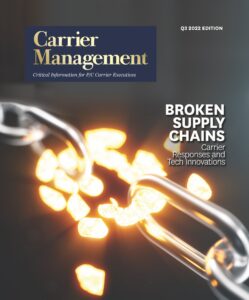Many reinsurers across the globe increasingly have been doing business with certain select managing general agents (MGAs), seen as market innovators, by reinsuring the fronting insurers that provide the paper for MGAs to underwrite.
In recent years, it is a trend that has continued from the soft market into the current hard market—as long as the interests of MGAs and their capacity providers are aligned.
“Reinsurers have been increasingly attracted to MGAs and have found an easy means to provide support through a dramatic expansion of the fronting market,” said Conning in a recent study titled “Managing General Agents—Firing on All Cylinders.”
“Total direct premiums written by the top 17 fronting companies [in the U.S.] rose by 45.3 percent to almost $9 billion in 2021,” said the report. Owned by Markel, State National is the largest and oldest fronting company, which saw gross premiums written rise by 31 percent to $2.7 billion and fee income rise 21 percent.
The fronting market has expanded in recent years because reinsurers want to get closer to the customers and to innovators, according to Danny Maleary, chief executive officer of Pro MGA Global Solutions, a London-based MGA incubator, which is currently supporting 41 MGAs. “A lot of the MGAs are very data driven, and, obviously, reinsurance is extremely data driven, so there’s an alignment in terms of proposition.”
“The appeal of MGAs has been particularly strong for reinsurers seeking to get closer to the end client,” agreed Conning in its report. “To take one among many examples, RenaissanceRe supports a management liability offering for startups offered through Boost, an InsurTech firm specializing in embedded insurance products that trades as an MGA.”
Included in the category of delegated underwriting authority enterprises (DUAEs) are MGAs, managing general underwriters (MGUs) and program managers.
Conning said that Munich Re leads the pack of reinsurers backing MGAs through fronting companies, “including supporting one of the fastest-growing tech-enabled cyber MGAs, At-Bay, through its subsidiary HSB Specialty Insurance Company.”
From a handful of companies led five years ago by State National, Conning said, there are now more than 20 fronting insurers operating in the U.S. MGA market. “Most of these are so-called hybrid fronts, retaining a share of risk (often as much as 20 percent), which serves as a further source of comfort to reinsurers,” said the report.
A fronting insurer typically only retains a very small proportion of the risk—about 20 percent or less—which makes it essential that the MGA develop a close relationship with its reinsurers, Maleary said. (The reinsurer would assume the remaining balance of the delegated authority portfolio.)
On the other hand, a traditional insurer would retain anything up to 80 percent of the MGA’s risk and then make a 20 percent quota share arrangement with its reinsurance partners, he added. However, because of the growing appetite from reinsurers who want to reinsure delegated authority business, some traditional insurers “are deciding to reduce their MGA retention level to 40 percent and reinsure 60 percent out the back.”
When reinsurers provide capacity for fronting companies, it enables them to get access to a portfolio of MGAs where there’s perhaps a greater level of diversification, which supports longer-term involvement from that reinsurer or a group of reinsurers, said Myles Gould, director, Analytics, AM Best.
Abundant Capacity
In recent years, MGAs haven’t had much difficulty accessing capacity—in both soft and hard markets. Industry practitioners say this is a change from five-plus years ago when insurers sometimes pulled capacity during hard markets because they had plenty of options for their capital deployment. And there have been other times when capacity exited markets when rates were too low.
“While we were in a soft market, there was a desire to support a broad number of MGAs in specific territories, across specific classes, and as the market started to harden, I did not see that change from a reinsurance perspective,” said Maleary.
“If anything, I saw [MGAs] becoming more sought after. While insurers were chasing those classes that were seeing rate increases, reinsurers decided it would be more beneficial for them to allocate their capital. I was also seeing insurers still supporting MGAs, but they were quota sharing a bigger proportion of the portfolio, out the back to the reinsurance market.”
“MGAs were historically most active in soft markets, when insurers were hungry for premium and turned to MGAs to develop niches that they could not readily access themselves,” the Conning report said.
“MGAs now serve as an all-weather distribution channel, as valuable to insurers in hard markets (such as we are now seeing) as in soft markets,” the report noted. “In terms of technology adoption and exploitation—particularly in rating hard-to-price risks—they have some advantages over the insurers themselves. They are not normally burdened by legacy systems and the inefficient and duplicative processes (sometimes known as tech debt) that go with these systems.”
Historically, during soft markets, insurers and reinsurers increasingly reached out to the MGAs to drum up business, to make up for those soft market conditions, commented Greg Williams, senior director at the ratings agency AM Best. However, that has changed over the past five years or so, and capacity now seeks to develop relationships with MGAs because they underwrite in specialty niches, he explained.
If MGAs are able to stay ahead of the curve and provide competitive advantage with innovation, they can keep that value-add in the chain, in all market cycles, said AM Best’s Gould.
Capacity has pulled back in some areas at some points in time for MGAs, Maleary said, but for most classes of business, if the MGA has delivered good quality results, is entrepreneurial and innovative, “then irrespective of whether it’s a soft or hard market, the MGA should be okay.”
Why would the capacity provider want to change that? he questioned.
Better Underwriting Performance
MGAs across the globe generally have better combined ratios than insurers, right across the board, according to David Howden, CEO of Howden Group, which comprises the broker Howden and DUAL, the international MGA. Howden spoke at the June conference of the Managing General Agents Association (MGAA) in London.
Over the past five years, the emergence of InsurTech MGAs, which are driven by some form of technology, such as algorithms and artificial intelligence, “have started to look at and analyze data in such a way that it is actually giving them a bit of a deeper insight into the risk they should be accepting—i.e., what’s good risk and what’s bad risk,” said Maleary.
Such models are helping to drive the better combined ratios for MGAs because they’ve got data “that’s helping them to slice and dice what’s good or bad,” he noted.
Attracting Talent
Howden discussed a number of key traits that are seen in successful MGAs: underwriting credibility (outperforming the market), being nimble, employing strong data and analytics, having alignment with their capacity providers, and talent.
MGAs have an enormous ability to attract talented underwriters who are seeking a slightly more entrepreneurial and empowered business model, Howden said.
Indeed, the Conning report suggested, the ability of the MGA model to attract talent in a post-pandemic world could have played a significant role in MGA formation in 2021, although this is hard to quantify. “[T]he more flexible business model of MGAs and, crucially, the greater sense of agency felt by people working at smaller and more nimble organizations may have contributed significantly to the allure of MGAs in competing for talent,” the report noted. (Related online article: “Are MGAs Winning the Insurance Talent War?”)
Culturally, MGAs are often attractive to the talent that traditional insurers are finding hardest to attract—including data scientists and software developers.
MGAs are much more nimble than traditional insurers, akin to a speedboat versus an oil tanker trying to change course, said Maleary.
MGAs provide a great mechanism for the industry’s entrepreneurial underwriters, who, after the pandemic, are less interested “in working for the man,” said Simon Burton, chief executive officer and chief underwriting officer for Greenlight Capital Re, in an interview.
“They’re very good at what they do. They’re super competent; they’ve got great relationships. They’ve got long track records, but they’d like to have a bit more autonomy, and, frankly, have greater participation in the profit of the business that they generate.”
“Most of MGA talent, from an underwriting perspective, is coming from large named insurers where maybe they’re No. 1 or No. 2 in line, but they want to work in a more entrepreneurial environment,” said Williams at AM Best.
Alignment of Interests
All the executives interviewed or quoted in this article mentioned “alignment” of interests as being crucial to strong, long-term relationships between MGAs and their capacity providers.
Maleary defined alignment as sharing the same vision, work ethic and approach (in terms of acquisition costs, in particular)—all helping to structure a strong commercial relationship that benefits all partners. One example, he said, would be to reward underwriters by the profitability of the portfolio.
Howden was dismissive of old preconceptions about MGAs and those insurers that are concerned about giving away their pens to MGAs. He called this type of talk “‘old hat, old thinking,’ and we need to change that.”
If MGA owners lose their capacity, they lose their business and they have no value, said Howden during his speech. “That is alignment.”
On the other hand, when a line underwriter gets told off by a CUO “for having written a crap risk—that’s not alignment,” said Howden. “And I think that message really needs to come across. MGAs are absolutely aligned to their capacity advisers and really care.”
“The MGA market has become much more professional. The talent pool is deeper; it’s more experienced. And then the insurers’ and the reinsurers’ enterprise risk management practices around audits have increased as well,” Williams explained. The rating agency has introduced a performance assessment for DUAEs to distinguish the best performing MGAs. (See related article from AM Best).
Misalignment of Interests
Burton recalled a period from a few years ago when risk capital was being undercompensated in MGA relationships—when there was a serious misalignment of interests.
He cited one example when Greenlight Re was offered three points of margin for an MGA’s business. “Frankly, three points of margin, after we overlayed our own expenses, would not even be breakeven. My response was that it simply wouldn’t work for us. But some of these deals were getting done, which wasn’t very healthy or sustainable for reinsurers or the market.”
The market was soft, and too much reinsurance capacity was chasing too little demand, Burton said, noting that ultimately, the situation caused a backlash and capacity withdrawal, including from MGAs.
“We only enter into relationships with MGAs where there’s a good alignment of interests. Put plainly, we can’t be in a situation where the reinsurance contract is a significant loser over a several year period while the MGA remains highly profitable.”
“Now it’s a matter of selecting the very best MGAs—the MGAs that are truly delivering the best value to their customers and for everybody in the value chain,” Burton said. Nowadays, when reinsurers go into a discussion with MGAs, “there’s an appreciation for the risk capital that reinsurers are bringing to the table and an understanding that there’s a fair amount of compensation that comes with that deployment of capital.”
This article first was published in Insurance Journal’s sister publication, Carrier Management.
Topics Insurance Wholesale
Was this article valuable?
Here are more articles you may enjoy.






 Consumer Acceptance of Telematics Widens, Says Survey
Consumer Acceptance of Telematics Widens, Says Survey  CEOs on Guard as Trump Rattles Companies With Series of Edicts
CEOs on Guard as Trump Rattles Companies With Series of Edicts  Georgia Republicans Move to Scrap State Income Tax by 2032 Despite Concerns
Georgia Republicans Move to Scrap State Income Tax by 2032 Despite Concerns  New York Governor Hochul Vows to Tackle Insurance Affordability, Litigation and Fraud
New York Governor Hochul Vows to Tackle Insurance Affordability, Litigation and Fraud 

